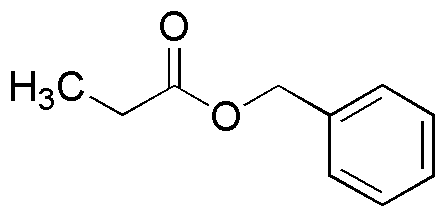Benzyl propionate is widely utilized in research focused on:
- Fragrance Industry: This compound is commonly used as a fragrance ingredient in perfumes and cosmetics, providing a sweet, fruity aroma that enhances product appeal.
- Flavoring Agent: In the food industry, it serves as a flavoring agent, particularly in candies and baked goods, contributing to a pleasant taste profile.
- Pharmaceutical Applications: Benzyl propionate is used as a solvent and excipient in the formulation of various pharmaceutical products, improving the solubility of active ingredients.
- Plasticizers: It is employed in the production of plasticizers, which enhance the flexibility and durability of plastics, making it valuable in manufacturing processes.
- Research and Development: In laboratories, it is often used as a reagent in organic synthesis, facilitating the creation of other chemical compounds and aiding in various research projects.
General Information
Properties
Safety and Regulations
Applications
Benzyl propionate is widely utilized in research focused on:
- Fragrance Industry: This compound is commonly used as a fragrance ingredient in perfumes and cosmetics, providing a sweet, fruity aroma that enhances product appeal.
- Flavoring Agent: In the food industry, it serves as a flavoring agent, particularly in candies and baked goods, contributing to a pleasant taste profile.
- Pharmaceutical Applications: Benzyl propionate is used as a solvent and excipient in the formulation of various pharmaceutical products, improving the solubility of active ingredients.
- Plasticizers: It is employed in the production of plasticizers, which enhance the flexibility and durability of plastics, making it valuable in manufacturing processes.
- Research and Development: In laboratories, it is often used as a reagent in organic synthesis, facilitating the creation of other chemical compounds and aiding in various research projects.
Documents
Safety Data Sheets (SDS)
The SDS provides comprehensive safety information on handling, storage, and disposal of the product.
Product Specification (PS)
The PS provides a comprehensive breakdown of the product’s properties, including chemical composition, physical state, purity, and storage requirements. It also details acceptable quality ranges and the product's intended applications.
Certificates of Analysis (COA)
Search for Certificates of Analysis (COA) by entering the products Lot Number. Lot and Batch Numbers can be found on a product’s label following the words ‘Lot’ or ‘Batch’.
*Catalog Number
*Lot Number
Certificates Of Origin (COO)
This COO confirms the country where the product was manufactured, and also details the materials and components used in it and whether it is derived from natural, synthetic, or other specific sources. This certificate may be required for customs, trade, and regulatory compliance.
*Catalog Number
*Lot Number
Safety Data Sheets (SDS)
The SDS provides comprehensive safety information on handling, storage, and disposal of the product.
DownloadProduct Specification (PS)
The PS provides a comprehensive breakdown of the product’s properties, including chemical composition, physical state, purity, and storage requirements. It also details acceptable quality ranges and the product's intended applications.
DownloadCertificates of Analysis (COA)
Search for Certificates of Analysis (COA) by entering the products Lot Number. Lot and Batch Numbers can be found on a product’s label following the words ‘Lot’ or ‘Batch’.
*Catalog Number
*Lot Number
Certificates Of Origin (COO)
This COO confirms the country where the product was manufactured, and also details the materials and components used in it and whether it is derived from natural, synthetic, or other specific sources. This certificate may be required for customs, trade, and regulatory compliance.


